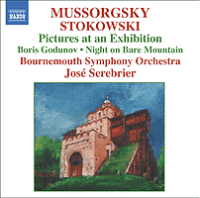|
You are reading the older HTML site
Positive Feedback
ISSUE
20
Stokowski symphonic transcriptions
Stokowski symphonic transcriptions: Mussorgsky, St. John's Night on Bald Mountain; Khovanshchina, Act IV, Entr'acte; Boris Godunov: A Symphonic Synthesis; Pictures at an Exhibition; Tchaikovsky, Solitude, Op. 73, No. 6; Humoresque, Op. 10, No. 2; Traditional Slavic Christmas Music. Bournemouth Symphony, José Serebrier (Naxos 8.557645) Leopold Stokowski regularly programmed his own arrangements of other people's music. His orchestral transcriptions of Bach organ works were perhaps the best known, but it was hard to tell at the time whether their success was due to Stokowski the arranger or Stokowski the conductor. This Naxos program proves—triumphantly—that even without benefit of the conductor's strong personality, these editions have much to offer. I suspect that Stokowski's orchestration of Pictures at an Exhibition will arouse most listeners' curiosity. It is almost impossible to judge Stokowski's arrangement without comparing it to Ravel's ubiquitous version, but surprisingly, Stokowski proves better attuned to the music's psychological progress. The violin intonation of the introductory Promenade suggests the viewer's anticipatory wanderings through the picture gallery better than Ravel's forthright brasses—an advantage somewhat obscured in the harder, more aggressive tonality of Stoky's own Decca Phase Four recording. After Gnomus, with its ominous brasses, a bassoon solo makes the following Promenade properly ruminative. It's Stoky, too, who more precisely realizes the pictorial elements—the pungent English horn suggests the medieval atmosphere of The Old Castle better than Ravel's unctuous alto saxophone, and the ostinatos of Bydlo, at a tempo more measured than Stokowski's own rather indiscreet hustle, hammer obsessively. Great Gate of Kiev, with its generous added tintinnabulations, crowns the performance strikingly. Stokowski omits the Tuileries and Limoges movements from the piano original, leaving only the Ballet of the Unhatched Chicks as a light diversion. I also thought I heard a few "different" chords near the start of Catacombs. Stokowski devised the "symphonic synthesis" as a way of knitting together operatic music for orchestral performance. The one he created for Boris Godunov is probably the best known, again because of the Decca Phase Four recording, although the LP era also saw similar sequences from Parsifal (Everest) and Tristan und Isolde (Columbia). Since Boris has been subjected to all manner of reorchestrations (by Rimsky-Korsakov and Shostakovich, among others) and other depredations for years, Stokowski's concert reordering is hardly beyond the pale. Right from the start, with its mournful solo bassoon, this performance is full of life and color, with the brass-dominated chorales assuming a solemn, organ-like tone. The individual episodes are connected by passages scored for quiet chimes and bells, which, as conductor Serebrier observes in the booklet, sound like Charles Ives! For Night on Bald Mountain, Stokowski claimed to follow the original more closely than Rimsky-Korsakov's well-known version, but it still sounds peculiarly and arbitrarily truncated, snipping a two-bar answering phrase here, a repetition there, producing an irregular, almost through-composed structure. The deployment of rapidly changing orchestral timbres within short spaces of time verges on the garish. Many passages that lack a really deep bass line sound lighter in weight than usual. All this nonetheless produces a sort of edge-of-the-seat suspense, since you're never quite sure what you'll hear next. Even at the end, a resplendent, affirmative cadence replaces Rimsky's quiet resolution. The extent of the conductor's ministrations to the Khovantschina Act IV prelude is unclear, and the booklet is not forthcoming. In any event, the broad string melody, as performed here, sounds deeply tragic. Two Tchaikovsky piano pieces usher in the encores. Humoresque sounds bright and chipper, and clearer in texture than Stravinsky's version in his Fairy's Kiss ballet, while Solitude, brief as it is, sweeps into anguished climaxes. (Be warned: the track listing reverses these. If you don't already know the pieces, you'll wonder at the unduly cheerful Solitude!) The "Traditional Slavic Christmas Music" is based on an old Russian hymn, or Ippolitov-Ivanov's setting thereof (the booklet hedges). The setting, for strings and brass only—no reeds—is reverent and heartfelt, again featuring organ-like, broadly sustained brass chorales. José Serebrier, a longtime Stokowski assistant, knows how this music should go, and more importantly, knows how it should sound. He can't, of course, replicate the Stokowski magic, but the string playing, though well controlled, sometimes suggests the shaggy, vibrant colors of old. The reproduction is vivid, with a wide dynamic range. The big percussion crescendos, many of which include gongs, sometimes obscure other orchestral details, but I suspect the arranger would have approved.
|

